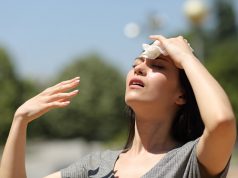Sunburn
The easiest way to avoid sunburn is to cover yourself up. When your skin is exposed, wear sunscreen and reapply every two hours whether you go in water or not. Also, try to avoid the sun during the peak hours of 10 am and 4 pm.
If you do burn, make sure to moisturize your skin using a moisturizer or Shea butter. Aloe Vera gel and mint can be used to help cool the pain and ease the burning sensation. You can also spray cold water on the area to ease any discomfort.
Food Poisoning
Warm summer temperatures create the perfect breeding ground for the most common bacteria that cause food poisoning. Stay safe by following these important rules.
- Wash your hands, utensils and food surfaces often.
- Keep raw foods separate from ready-to-eat foods. When shopping, preparing food or storing food, be mindful to keep raw meat, poultry and fish away from other foods. This prevents cross-contamination.
- Cook foods to a safe temperature. You can kill harmful organisms in most foods by cooking them to the right temperature.
- Refrigerate or freeze perishable foods promptly within two hours of purchasing or preparing them or within one hour if the room temperature is above 32.2 C/90 F.
- Don’t thaw food at room temperature. Defrost food safely by defrosting it in the refrigerator. If you microwave frozen food using the “defrost” setting, be sure to cook it immediately.

Reference: Mayo Clinic
Heat Stroke
Heat stroke is usually a result of prolonged exposure to or physical exertion in high temperatures. Symptoms include a high body temperature of 40 C/104 F or higher, headache, confusion, agitation, irritability, delirium, seizures, nausea, vomiting, flushed skin, rapid breathing and elevated heart rate. Heatstroke requires emergency treatment, so immediately get the affected person to a shaded area and particularly shade the head from the sun. Remove excess clothing and cool the person by whatever means available – place them in a cool tub of water or under a cool shower, spray them down with a garden hose, sponge with cool water, fan while misting with cool water, or place ice packs or cold, wet towels on the person’s head, neck, armpits and groin. 
Swimmer’s Ear (Otitis Externa)
The problem occurs when you go swimming and then allow water to dry out naturally, creating a moist environment that aids bacterial growth. Symptoms include itchiness and discomfort as well as a discharge. To prevent swimmer’s ear, make sure to dry your ears out thoroughly after swimming rather than letting them dry out naturally. If the problem has already set in, then avoid using cotton swabs which can worsen the problem. Usually you can treat swimmer’s ear with eardrops. Prompt treatment can help prevent complications and more serious infections.







